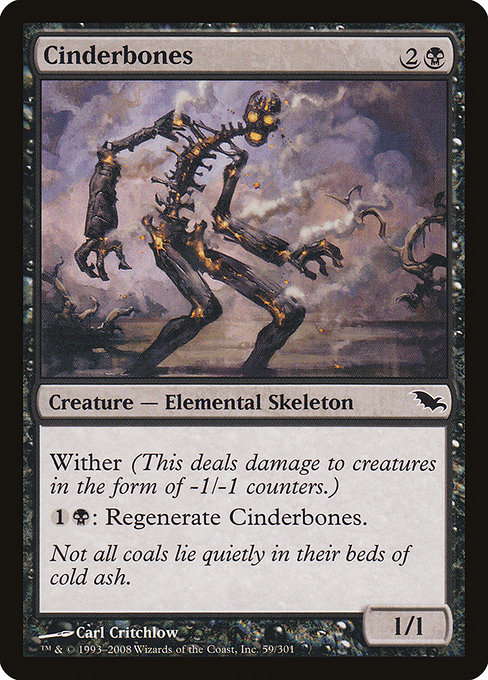
Image courtesy of Scryfall.com
Flavor and Lore: Cinderbones as a Thread Through Shadowmoor’s Dark Tapestry
Shadowmoor arrived like a lullaby sung in a coal-fired furnace—beautiful, dangerous, and a little delirious. In this era of embers and ash, Cinderbones stands out not just for its stats or its wither-by-default toolkit, but for how it stitches together the set’s broader mood: a world where life clings to heat and bone, where black mana isn’t merely void but a forge for necrosculpted forms. As a Creature — Elemental Skeleton costed at {2}{B} with a modest 3 total mana, Cinderbones embodies the duality Shadowmoor loves: beauty in decay, vitality born of ruin. 🧙🔥💎
Not all coals lie quietly in their beds of cold ash.
The card’s core mechanic—Wither—turns conventional damage into -1/-1 counters. That single keyword unthreads a narrative thread that runs through many of Shadowmoor’s black creatures: death is not the end but a translation, a shift in the board’s architecture. Cinderbones doesn’t just hit; it reshapes. And when you add Regenerate to the mix for a small investment of {1}{B}, you get a skeletal fighter who can weather a day’s sweep and stand again, a walking remnant that refuses to stay ash. The flavor text, with its coal-and-ash imagery, reinforces this theme: even in a world that looks spent, fire and bone can rekindle, counter-intuitively, through a stubborn spark. 🎨⚔️
Design and Theme: How the Wither Character Finds Its Voice
Cinderbones’ Wither ability aligns perfectly with Shadowmoor’s aesthetic of transformation through pressure. Where many sets celebrate raw aggression, Shadowmoor asks us to contemplate the costs of power. Wither makes damage count differently—your creatures don’t just shrink; they carry the weight of negative counters, altering combat math and forcing your opponent to improvise. The presence of regeneration as a defensive answer adds a layer of strategy: you can keep the skeleton on the battlefield, dragging the game into a slower, more methodical tempo that suits black’s penchant for reclamation and resilience. This pairing—Wither plus regeneration—serves as a microcosm of the plane’s ingenuity: life, death, and the stubborn ember that binds them. 🧙🔥
Artist Carl Critchlow’s illustration backs this theme with a stark, ember-bright palette and a silhouette that feels both ancient and immediate. The creature’s bone-white structure contrasted against smoky, ash-dusted textures evokes the moment a bonfire’s last spark lurches back to life. It’s a visual reminder that in Shadowmoor, even the simplest creatures carry a story of heat, pressure, and transformation—an idea that extends beyond a single card to the very fabric of the set. The symbolism of coal and flame threads through other black creatures in the block, creating a cohesive narrative arc about rebirth from ruin. 🎨
Story Continuity: Linking Cinderbones to Shadowmoor’s Dark Motif
Across Shadowmoor’s lineup, Cinderbones acts as a connective tissue piece: a straightforward, repeatable body on the battlefield whose wither trait echoes the era’s fascination with -1/-1 counters as a representation of decay’s creeping triumph. The skeleton’s elemental identity merges the classic bone motif with a forge-born energy, hinting at a world where even the dead can be shaped by the plane’s fiery forges and smoky skies. The flavor text’s coal-ash metaphor dovetails with other Shadowmoor cards that lean into metamorphosis—where a creature’s fate isn’t sealed by a single combat or swarm, but by a slow burn that redefines what “survival” means in the moment. In this sense, Cinderbones isn’t an isolated oddity; it’s a deliberate thread that helps reveal how Shadowmoor treats life, death, and the spaces in between. 🧙💎
Playstyle and Deckbuilding: Why Cinderbones Finds a Home in Your Black Deck
On the practical side, Cinderbones is a flexible piece for any black-centric strategy that wants to leverage -1/-1 counters. With a base 1/1 body, it asks the board to acknowledge the power of wither—your opponent’s creatures shrink in a way that simple damage wouldn’t achieve. The sweet spot is pairing with other wither-enabled threats or with board-control packages that flood the battlefield with small, persistent pressure. Regeneration as a nudge-or-null option makes Cinderbones a resilient line of defense, especially against removal-heavy decks that might otherwise derail a midrange plan. And because it’s a common from Shadowmoor, you’re not breaking the bank to slot it into a casual, love-for-the-lore build. In total, Cinderbones plays nicely with the slow-burn calculus black players adore: it buys time, chips away at a larger creature presence, and embodies the plane’s gritty resilience. 🧙🔥⚔️
From a collector’s lens, Cinderbones sits in a practical price tier for most modern playgroups: non-foil around a few dimes, foil versions a few dollars—enough to feel like a meaningful upgrade without demanding a mortgage. Its EDHREC footprint might be modest (rank around 18,394), but its flavor-filled presence elevates casual EDH experiences with a touch of Shadowmoor’s smoky poetry and a nod to the era’s distinctive mechanics. If you’re building a nimble, midrange black shell that wants to trade efficiency for inevitable inevitables, Cinderbones rewards patient play and thoughtful counter-totals. The card’s built-in lore support makes it an easy “story choice” for players who want their board state to feel like a chapter in Shadowmoor’s ongoing saga. 🧙💎🎲
While you’re cooking up your next Shadowmoor throwback or teaching a friend the joys of wither, you might also want a little something to wear or show off while you scrub through decklists on your phone. That’s where a certain neon-themed phone case comes into play—because every nerd needs a stylish way to carry card art into the real world. Neon Phone Case with Card Holder MagSafe 1 Card Slot isn’t just a splash of color; it’s a practical companion for game night, tournament runs, or casual Friday gatherings. And if you’re curious, you can grab it here. 🧙🔥💎